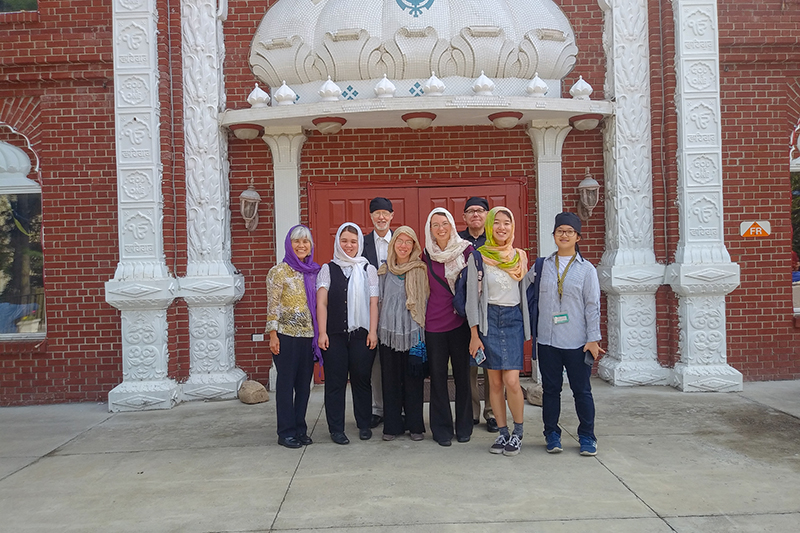YSP Adventures into Sikhism
Youth and Students for Peace (YSP) Program Coordinator Naria Gaarder organized a group visit to the Gurudwara Sikh Temple in Glen Rock, NJ on August 18. The trip provided eight young participants with an opportunity to learn about Sikhism and experience their prayer service.
Before entering the temple, the group took a moment to prepare their scarves and headwear. Upon seeing that some participants did not have the proper head attire, one Sikh gentleman freely offered black head covers and helped put them on.
A young man named Amitoj explained the features of the building to the group and answered some questions about Sikhism. Then, a man named Janit Singh joined the group and answered more questions in depth. Participants toured the building, enjoyed light refreshments in the dining area called the Langar Hall, and visited the prayer room called the Darbar Hall. Janit explained the two styles of prayer used during service: singing (Kirtan) and verbal recitation (Kartha) of their holy scriptures. Following the “Ardas,” or the concluding prayer, everyone enjoyed a vegetarian meal together in the Langar Hall.
Throughout the day, the group learned many things about Sikhism, including the meaning of the Sikhism symbol, Khanda, which is made up of three swords and a circle. They also learned that when Sikhs greet one another, they put their hands together in front of them as if in prayer and say “Waheguru Ji Ka Khalsa, Waheguru Ji Ki Fateh,” meaning the Khalsa (pure people) belong to God and victory belongs to God.
Reflections
“I had so much fun visiting the Sikh Temple because from that experience I was able to learn about their faith. Some of the things I learned from their religion is men/women wear the metal bracelets called Kara. Kara is one of the five Kakars. It’s a reminder to always keep one consciousness to God. All Sikhs, even the little ones, wear one. I also learned about the three golden rules which are similar to the three great blessings. The three duties are Nam japna, which is “Keeping God in mind at all times,” Kirt Karna, which is “Earning an honest living,” and Vand Chhakna, which is “Giving to charity and caring for others.” The third thing I learned is after the Sunday service they gave us little treats, which is basically God’s offering and it’s made out of flour, clarified butter, and sugar. The last thing I learned was that they didn’t believe in fasting. I think my favorite part of the experience was the prayer because I felt the spirit from God and even though we couldn’t understand (because it wasn’t in English), I still felt like this is how they believe in God and understand God’s heart.” ─Reina Sato, 15
“To be honest, I would say I want to convert. But then again, I think so far I’ve been saying that about every religion I learn something about, and it was through this experience that I realized this.
“The thing that stuck out most to me was that the Sikh people live strictly according to one scripture. From reading the scripture and singing it (the singing was really nice, it was like at the mosque where they would recite lines from the Qur’an) they learn how they should live. This is basically like the idea of strictly living by the Divine Principle (DP) for us. That’s cool. They also believe in reincarnation; however, they are very concentrated on the present life and they believe that God put us on Earth so that we may do good. The three rules they abide by are sort of like the three great blessings, which is also cool.
“Now the thing that I really loved the most were the words of the actual scripture itself. I don’t remember exactly, but I remember I started really reading the lines and tried to understand them after reading “God is a playful and wondrous God.” When I read this, I thought about how God just wants to be happy and is waiting for that happiness to finally exist.
“This led me to the conclusion that religions are all ways God has been looking to bring us back to Him. They are all truths but maybe different interpretations, and the DP is the clear truth that is easier to understand without such misinterpretations.
“My friends told me that religions are very different from each other, but whenever I learn about them I feel like, no, they actually all have the same core beliefs and it’s just how they carry out those beliefs that is different. I really love the different religions and what they entail. I feel like uniting them all is actually feasible, despite what my school friends say. The DP really does hold those core beliefs that religions generally have in common, I think. I loved it, it was great!” ─JungHae Joo, 16
























